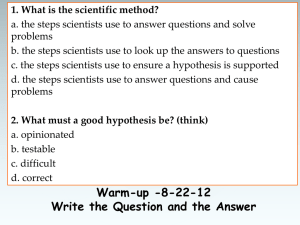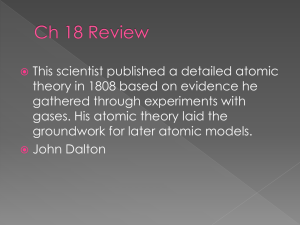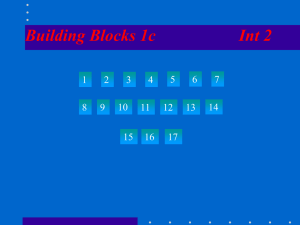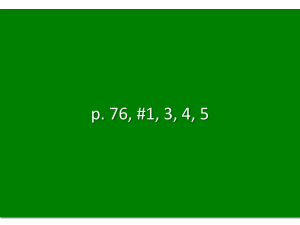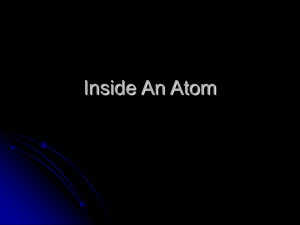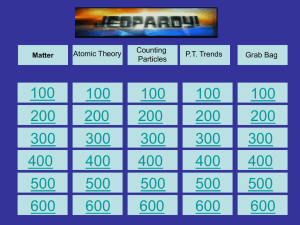Atoms
advertisement
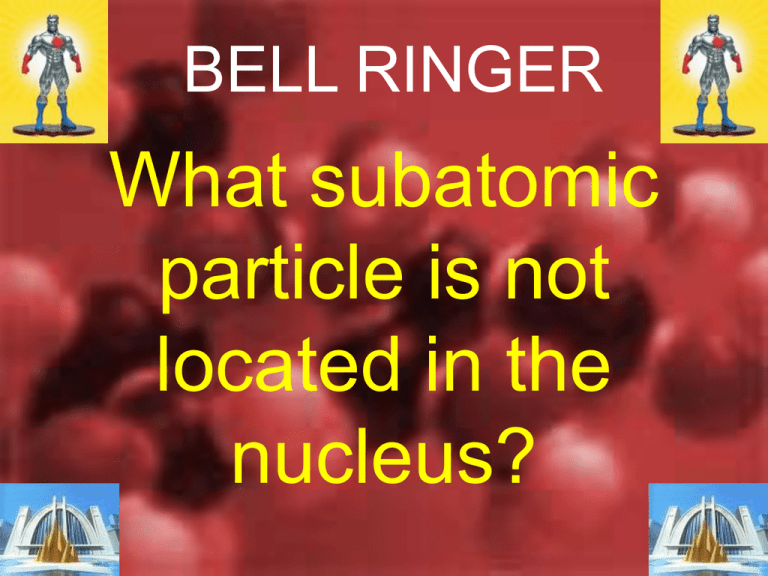
BELL RINGER What subatomic particle is not located in the nucleus? Atomic History Research Chapter 3 Review Book – Topic 1 Chapter 1 BELL RINGER What are the nucleons (things in the nucleus)? 1. Who did the gold foil experiment? 2. Who first named an atom? 3. According to Bohr, where are electrons located? 4. Draw an atom according to Democritus. 5. Who discovered the electron? A. Ancient Greece (2000+ years ago) Democritus - believed that matter could not be continuously divided - Matter consists of small indivisible particles “Atomos” = Atom indivisible - Aristotle did not agree his teacher Particles are in continuous motion Four elements make up all matter and energy Earth, Wind, Water, Fire! No scientific evidence to show this. by 1700s (scientific revolution), all chemists agreed: on the existence of atoms that atoms combined to make compounds B. Dalton’s Atomic Theory - 1803 1. All matter is composed of small particles which cannot be broken down (atoms) same as Democritus 2. All atoms of the same element are identical in size, mass and properties. Atoms of different elements are different in size, mass and properties Hydrogen Sulfur 3.Atoms of different element combine in simple ratios to make PbO2 compounds H2S 4. In chemical reactions, atoms are combined, separated, or rearranged (No atoms are created or destroyed) So at this point, we believe that an atom is like a small solid ball of matter that cannot be split up Some parts of Dalton’s theory were wrong: AMENDMENTS atoms are divisible into smaller particles (subatomic particles) atoms of the same element can have different masses (isotopes) Matter can be lost - Nuclear C. J.J. Thomson - 1897 Experimented with cathode rays Used electric field to show that cathode rays are negatively charged particles DISCOVORED THE ELECTRON After discovery of the proton, Thomson assumed an atom was a mixture of + and – charged particles, all mixed up Plum-Pudding Model +- + - + -+ - + D. Rutherford Ernest Rutherford wanted to determine what an atom looked like. Fired (+) charged alpha particles at a very thin piece of gold (Gold foil) Put a screen behind the foil to determine what happens to the rays Gold foil Radioactive source Most of the rays went straight through the foil Some rays deflected A very few rays came straight back Screen Click on me!!! Rutherford explained this by stating that a. Atoms have mostly empty space This is why most rays went straight through b. There must be a dense positive center to an atom This is why the positive rays deflected. (Positive rays are repelled by positive charged objects) - + - - - Rutherford model Later experiments showed that electrons exist in the space between nuclei includes all particles inside atom proton electron neutron charge on protons and electrons are equal but opposite to make an atom neutral, need equal numbers of protons and electrons number of protons identifies the atom as a certain element protons and neutrons are about same size electrons are much smaller # protons = atomic number # electrons = # of protons (for now) # neutrons = mass number– atomic number p n e 3 4 3 23 Na 11 11 12 11 9 4 4 5 4 26 30 26 7 Li 3 Be 56 Fe 26 BELL RINGER Give the p, n, and e in a neutral atom of Silver. p n e 17 18 17 Hg 80 121 80 Xe 54 77 54 22 26 22 Cl 17 201 X 22 Nucleus: contains protons and neutrons takes up very little space Electron Cloud: contains electrons takes up most of space E. Bohr - looked at the arrangement of electrons Electrons exist in definite areas around the nucleus Energy levels e- e- Further from the nucleus, an electron has more energy ee- Electrons can gain energy and “jump” to higher levels nucleus They can then give off the energy as they jump back down Energy levels are numbered 1,2,3,4,5,6,7 •With 1 being closest to the nucleus and having the least amount of energy All atoms have the same types of energy levels + - - - - Planetary model F. Wave Mechanical Model Aka – ‘Electron Cloud’ Dr. Wave Mechanical Modified Bohr’s model Electrons are not in circular orbits, but exist in specific spaces around the nucleus Pattern is random, unpredictable •most dense near nucleus level Energy levels contain sublevels nucleus level Review of Atoms Dalton Bohr Thompson Rutherford Democritus Wave Mechanical Electron Location • Located in energy levels outside of the nucleus • The closer to the nucleus = less energy • The farther away from the nucleus = more energy Electron Location Electrons are located in energy levels or shells. There are a bunch of energy levels and each level can “fit” only a limited number of electrons. 2 2n Where ‘n’ represents the energy level Energy level 1 can have Energy level 2 can have Energy level 3 can have Energy level 4 can have - 2 e8 e18 e32 e- Bohr Diagrams Gives the location and the number of the p, n, and e. Draw the Bohr diagram for Oxygen: p= 8 n= 8 Valence e- = 6 Answer p= 9 n= 10 Valence e- = 7 BELL RINGER What did Rutherford contribute to the development of the atom? Ge 6. Sodium 2. Manganese 7. Cr 3. As 8. Krypton 4. Phosphorus 9. Be 5. Ti 10.Boron 1. The above is an example of a ground state electron configuration (=the configuration on your R.T.’s) Each electron in an atom has its own distinct amount of energy. Electrons in the first energy level have the lowest potential energy since they are located closest to the nucleus. As an electron gains a specific bunch of energy, the electron “jumps” to a higher energy state (excited state). p= 10 p= 10 n= 10 n= 10 Ground State e- Configuration for Ne 2-8 Excited State e- Configuration for Ne 2-7-1 How is light produced? Absorbs nrg p= 10 n= 10 n= 10 Gives off Ground State Releases nrg p= 10 e- Configuration for Ne Excited State 2-8 e- Configuration for Ne 2-7-1 When an electron returns from a higher energy state to a lower energy state, a specific amount of energy is given off --> RELEASED Each element gives off a certain color or spectrum of colors. You can identify unknown elements by the color of light that they give off. Bohr Animation Ions So far we have only talked about electrically neutral atoms, atoms with no positive or negative charge on them. Atoms, however, can have electrical charges – They can gain/lose e-. Some atoms can either gain or lose electrons The number of protons never changes in an atom. Ions If an atom gains electrons, the atom becomes negatively charged. the atom loses electrons, the atom becomes positively charged (because the number of positively charged protons will exceed the number of electrons). An atom that carries an electrical charge is called an ion. If Ions Listed below are three forms of hydrogen; 2 ions and the electrically neutral form. H+ : a positively charged hydrogen ion H- : a negatively charged H : the hydrogen ion hydrogen atom Ions Neither the number of protons nor neutrons changes in any of these ions, therefore both the atomic number and the atomic mass remain the same. H+ : a positively charged hydrogen ion H- : a negatively charged H : the hydrogen atom hydrogen ion Ions Identify the number of subatomic particles in the following ions: A.) + Na B.) F C.) -2 O p 11 9 8 n 12 10 8 e 10 10 10 BELL RINGER Which is the electron configuration of an atom in the excited state? 1)2-8-2 2)2-8-1 3)2-7-1 4)2-8-3 When subjected to a flame, solutions containing certain metals have characteristic colors corresponding to the energy released when excited electrons return to lower energy levels. Ions Identify the number of subatomic particles in the following ions: A.) +2 Mg B.) Br C.) + K p 12 35 19 n 12 45 20 e 10 36 18 BELL RINGER Draw the Bohr -1 diagram for a F ion. atoms of the same element with different numbers of neutrons most elements exist as a mixture of isotopes Disproves Dalton’s theory What do the Carbon isotopes below have in common? What is different about them? sum of the particles in nucleus = #p + #n This is a whole number!!! How many protons do each of the hydrogen atoms below have? Ions/Isotopes PRACTICE PROBLEMS since masses of atoms are so small, it is more convenient to use relative atomic masses instead of real masses to set up a scale, we have to pick one atom to be the standard since 1961, the carbon-12 nuclide is the standard and is assigned a mass of exactly 12 amu (=atomic mass unit) REFERENCE TABLES atomic mass unit (amu)- one is exactly 1/12th of the mass of a carbon-12 atom mass of proton= 1.007276 amu = 1 amu mass of neutron= 1.008665 amu = 1amu mass of electron= 0.0005486 amu = 0 amu weighted relative atomic masses of the isotopes of each element each isotope has a known natural occurrence (percentage of that elements’ atoms) An element has three main isotopes with the following percent occurances: #1: 19.99244 amu, 90.51% #2: 20.99395 amu, 0.27% #3: 21.99138 amu, 9.22% Find the average atomic mass and determine the element. =20.179 amu Naturally occurring copper consists of: Cu-63 Cu-65 Actual Mass 62.929amu 64.927amu Percent Abundance 69.71% 30.83% 100.54 Relative abundance .6971 .3083 1.0054 Relative Mass 43.87 20.02 63.89 BELL RINGER Isotope AMU 32S 31.97 32.97 33.97 35.97 33S 34S 36S Natural Abundance 94.93% 0.76% 4.29% 0.02% Calculate the average atomic mass of Sulfur. 32.06 amu There are two isotopes of Silver, Ag-107 and Ag-109. 52% of the isotopes are Ag107, what is the average atomic mass of silver? Ag-107 52% = 5564 Ag-109 48% = 5232 10796 ÷100 =107.96 BELL RINGER Identify the number of p, n, and e in the following: 37 17 Cl 1 Spectroscopy The energy emitted is in the form of radiant or light energy which corresponds to a bright-line spectrum. Each element has its own signature or bright-line spectrum. There are several kinds of spectra, such as: continuous & bright line. A continuous spectrum is, as the name implies, a parade of all the colors from the deepest red to the ultraviolet - of which the rainbow in the sky is a good example. In the laboratory, a continuous spectrum can be produced by heating a solid - Light from the electric lamp filament, for example, produces such a spectrum. When light emitted by a gas through which an electrical discharge is passing produces a spectrum consisting of a few isolated parallel lines, it is known as a "bright line spectrum" The characteristic color of neon signs is due to bright red and orange lines in its spectrum. The typical color of neon signs is due to the great intensity of the red and orange lines. A group of elements would create a combination of spectral lines Element X Element Y 3 different electron jumps Elements X and Y combined Notice how the combination of X and Y is just a combination of the individual spectral lines? Some Atomic Emission Spectra Hydrogen Mercury Argon Helium It should be carefully noted that each element always gives the same pattern of lines. Each element, so to speak, has its own fingerprints, possessed by no other element. This fact is utilized in chemical analysis and in many other applied fields. BELL RINGER Identify the number of electrons and neutrons in the following: 1)Ti +3 -2 2)S What element is the unknown? Unknown Atomic History DEMOCRITUS named the most basic particle atom- means “indivisible Atomic History DALTON 1. 2. 3. 4. Atoms of same element have the same size, mass, and properties Atoms can’t be subdivided, created or destroyed Atoms of different element combine in whole number ratios to make compounds In chemical reactions, atoms are combined, separated, and rearranged. Atomic History DALTON Some parts of Dalton’s theory were wrong: atoms are divisible into smaller particles (subatomic particles) atoms of the same element can have different masses (isotopes) Most important parts of atomic theory: all matter is made of atoms atoms of different elements have different properties Atomic History RUTHERFORD ‘Gold Foil Experiment’ Atom is mostly empty space Small, hard, dense positive part = NUCLEUS Atomic History JJ THOMSON discovered the e- Atomic History NEILS BOHR Electons in ‘orbit’ protons in nucleus Atomic History MODERN MODEL protons in nucleus Electrons in an orbital – most probable location Atomic History SUMMARY What we know about the atom has been the work of many scientists over thousands of years! WHITE BOARD REVIEW BELL RINGER How much heat energy in joules is released by 25.0 grams of water when it is cooled from 75.2ºC to 31.9 ºC? Get the formula from Reference Tables q = mcΔT q = 25.0g (4.18J/g•ºC) 43.3ºC q = 4525 J


